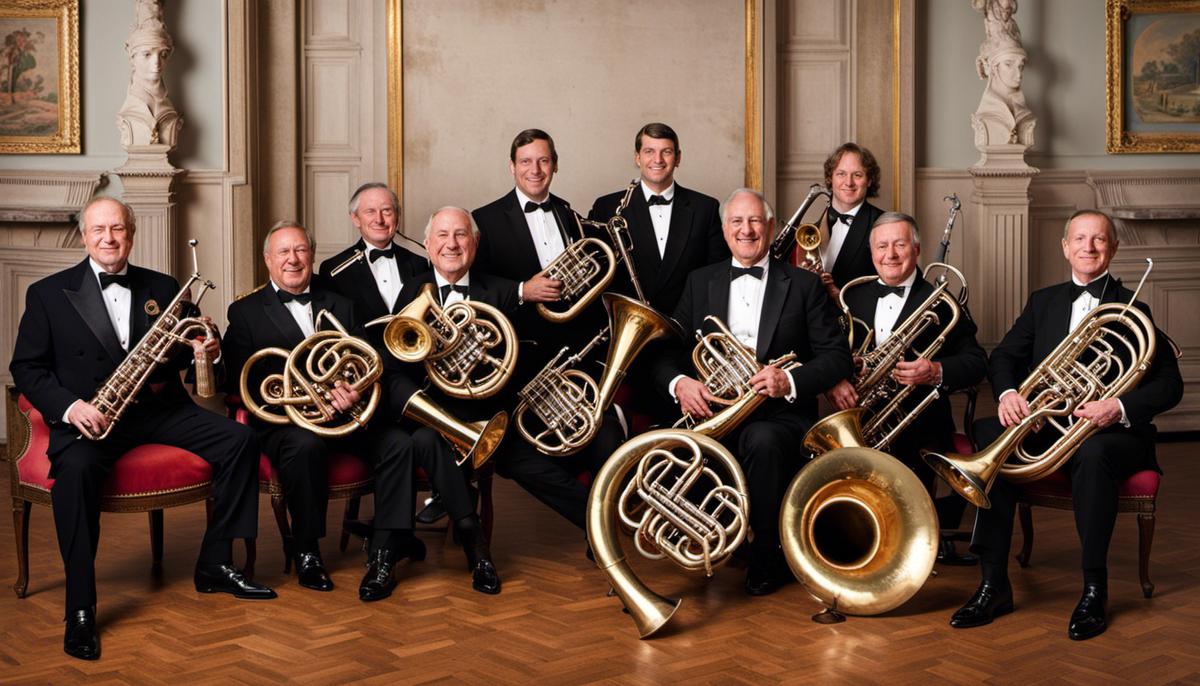Table of Contents
Introduction
The enchanting world of musical instruments beckons us with its allure, rich history, and the sheer magic of sounds. Among these instruments, two horns stand apart due to their distinctive characteristics, cultural significance, and the mesmerizing tones they produce. English Horn vs French Horn, although sharing a common name, have strikingly different histories, construction, and musical roles.
This exploration submerges into the exciting universe of these two horns, traversing their historical origins, physical elements, playing techniques, musical genres they dominate and their unique sounds. With this information, hobbyists and musicians can deepen their understanding, appreciate each horn’s uniqueness, and potentially, decide which instrument aligns more closely with their musical vision.
Historical Origins and Evolution (English Horn vs French Horn)
English Horn
The English horn, contrary to its name, is not English in origin and is not a horn. It is actually a woodwind instrument, a sibling of the oboe, and its real name in French is “cor anglais”, which translates to “angled horn”. The “English” in its name was a mistranslation of the word “angled”. Its inception is much debated but it generally believed to have been developed in Germany in the 18th century.
Initially, English horns were not widely used. But from the early 19th century onward, they became more common in orchestras, mostly being used for solos and to add color to the orchestral sound. They have a unique pear-shaped bell at the end which gives it a distinctively plaintive and haunting tone.
The modern English horn is essentially a large oboe, pitched a perfect fifth lower. The instrument is approximately one and a half times the size of an oboe. The English horn uses a similar fingering system to the oboe, though its larger size and the angled position in which it is played necessitate a slightly different hand position.
The English Horn has had notable roles in works by many celebrated classical composers, including Beethoven, Wagner, and Tchaikovsky, to name just a few. Its unique sound continues to captivate audiences and makes it a valuable addition to the orchestral family.
French Horn
The French horn dates back to the Middle Ages, around the 11th century, but it was only in the 17th century that it evolved into the instrument we recognize today. Originally, horns were simple brass tubes with a flared opening (bell) at the end. They were used for signaling and ceremonial purposes. In the 17th century Europe, in particular, France and Germany, horns became part of the orchestral ensemble.
In the mid-18th century, the French horn underwent significant development. German musician Anton Joseph Hampel introduced the hand technique in horn playing, which involved placing a hand in the bell to alter the pitch. This led to the design of the single “F” horn, the staple of the orchestral horn section until the 20th century, when the double “Bb/F” horn, a more versatile instrument with a larger range, became the standard.
The modern French horn has 18 feet of tubing wound into a coil, with a large flared bell. It has three rotary valves, though some varieties may have four. The modern French horn tends to have a rich and full sound, making it a vital part of symphony orchestras and brass ensembles.
The French horn and the English horn, while they appear substantially different in design, operation, and resonance, are linked by a vibrant shared history. Their unique contributions to orchestras and ensembles are invaluable, and their distinctive sounds continue to enrich the tapestry of music.
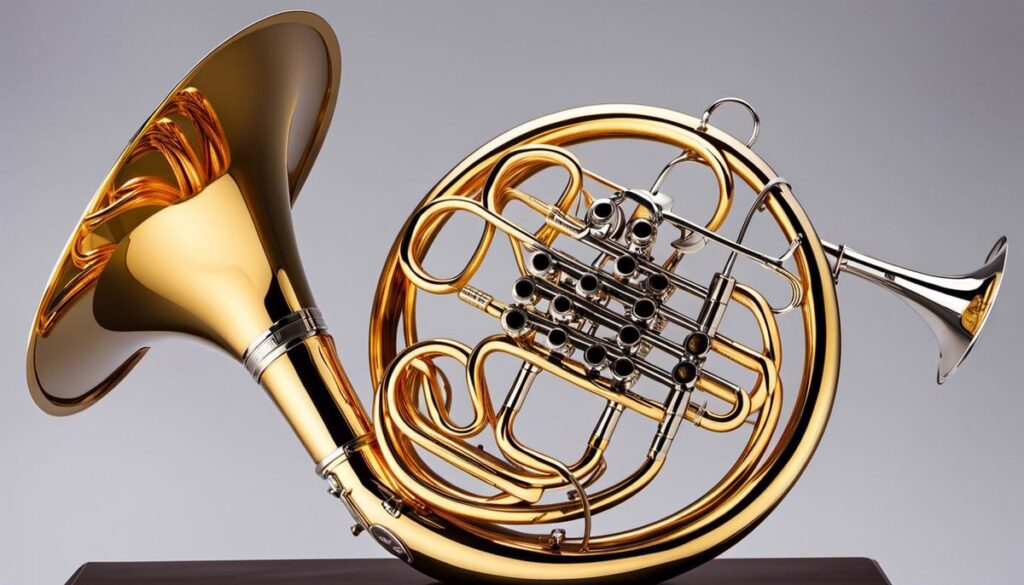
Physical Characteristics and Construction
Understanding the French Horn: Physical Attributes and Construction
The design and design of the French horn, sometimes referred to as just ‘horn’, is unparalleled and intricate. This instrument belongs to the brass family and boasts a coiled, winding shape with an oversized bell at its end. Typically, if you were to unravel a French horn, it would stretch out to about 12-13 feet, which makes it among the larger instruments in the brass family. Crafted from brass or metals of a similar nature, like silver or nickel silver, the physical construction of the French horn plays a pivotal role in creating its characteristic sound. The detailed coiling in combination with the large bell results in a rich, mellow tone which has an expansive range of musical potential.
The French horn generally has three to four rotating valves but variants with a higher number of valves exist. The right hand is usually employed to operate the valves while the left hand is used inside the bell, fine-tuning the pitch. This use of the hand inside the bell is a unique feature not commonly seen in other brass instruments.
Physical Characteristics and Construction of the English Horn
Despite its name, the English horn, or cor anglais, is not a horn at all, but a woodwind instrument. It closely resembles an elongated oboe, both in its physical shape and its method of sound production. The English horn is constructed using high-quality, heavy resinous wood such as Grenadilla, which is known for its dense, strong properties. It measures about 36 inches in length, making it larger than the oboe, which is why its sound is deeper and more mellow.
On the English horn, the conical bore widens out slowly to produce its distinctive bell shape at the end. It uses a double reed, which is similar to the oboe’s but larger, contributing to the English horn’s distinctively lower pitch and fuller sound. The instrument also has a characteristic bell at the end with a metal cap, known as a pear-shaped bell, which subtly impacts the sound quality, providing a darker and warmer tone than the oboe.
Unlike the French horn, the English horn is played using both hands on the instrument’s keys, rather than leaving one inside the bell. The fingering system of the English horn is identical to that of the oboe, although the keys themselves are slightly bigger due to the larger size of the instrument.
Understanding the Contrast of the English Horn vs French Horn
The French Horn and the English Horn are often mistaken for being similar due to the word “horn” in their names. However, they drastically differ in terms of their structure, the family they belong to, the materials they are made from, and how they produce sound. The French Horn, known for its distinctive metallic build and swirling structure, creates a rich and sonorous tone. On the other hand, the English Horn, made from wood with a conical bore, produces a deeper, more serene sound. Therefore, playing each instrument needs distinct technical prowess and understanding, allowing for a wide range of musical expression.
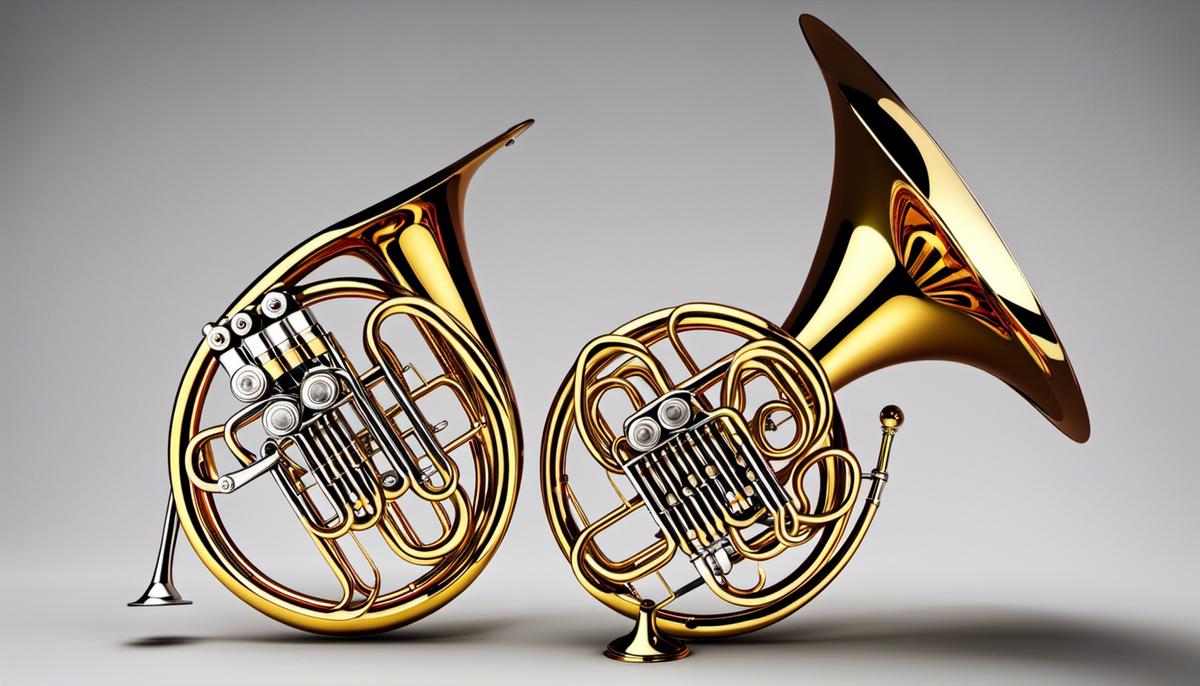
Playing the Instruments
The Art of Playing the French Horn: Techniques and Obstacles
The French horn has earned the notoriety of being one of the most challenging instruments in the brass family to learn and master – its unique structure posing particular demands. One such demand is the unusual left-hand positioning. Unlike most brass instruments utilizing a three-valve system, the French horn comes with a set of rotary valves operated by the left hand. Each finger, the index, the middle, and the ring, wrap around the valve levers in a distinctive sequence.
Breath control in French horn playing is crucial due to its expansive bore size and elaborate tubing. One of the key techniques, known as “stopping,” requires players to put their hand inside the bell, resulting in a tonal modification. Precision in this technique is of the essence and is a tough art to master. It demands a finely tuned mixture of right pressure and exact positioning to create a coherent sound.
Another unique aspect of playing the French horn is perfecting the embouchure, defined as the lip’s position on the mouthpiece. This requires concentration and precision to generate a flawless tone. The key is to strike a balance between tension and relaxation of the lips.
English Horn: Playing Techniques and Challenges
Contrary to its brass counterpart, the English horn is a double-reed woodwind instrument that demands its own unique set of skills. Holding the English horn involves a right-hand-underneath grip, with three fingers of each hand – namely the thumb, index, and middle finger – primarily used to manipulate the keys, while the pinky fingers control a series of auxiliary keys.
The fingering system for the English horn is vastly different from the French horn, involving combination of keys rather than valves. The challenge lies in mastering the various alternate fingerings that allow for smoother transitions between notes and optimal intonation.
Wind control is pivotal in English horn performance, requiring players to expertly manage their breath to create a consistent and unwavering sound. Embouchure, much like in French horn, is outmost important in English horn playing, where the lips and facial muscles work to control the vibration of the double reed used in this instrument.
Obtaining a satisfactory sound on the English horn can be particularly tricky as the double reed needs diligent care and regular replacement. The first challenge to many players is learning to form and control the double reed, making it work perfectly in correspondence with their embouchure and breath.
The French horn and the English horn, despite their varying characteristics, share common hurdles that necessitate dedication, extensive practice, and customized learning to overcome. Mastering these instruments pivot on certain key skills such as precise fingering, control over one’s breath, and command over embouchure. These facets greatly influence a musician’s performance and the quality of the sound produced.
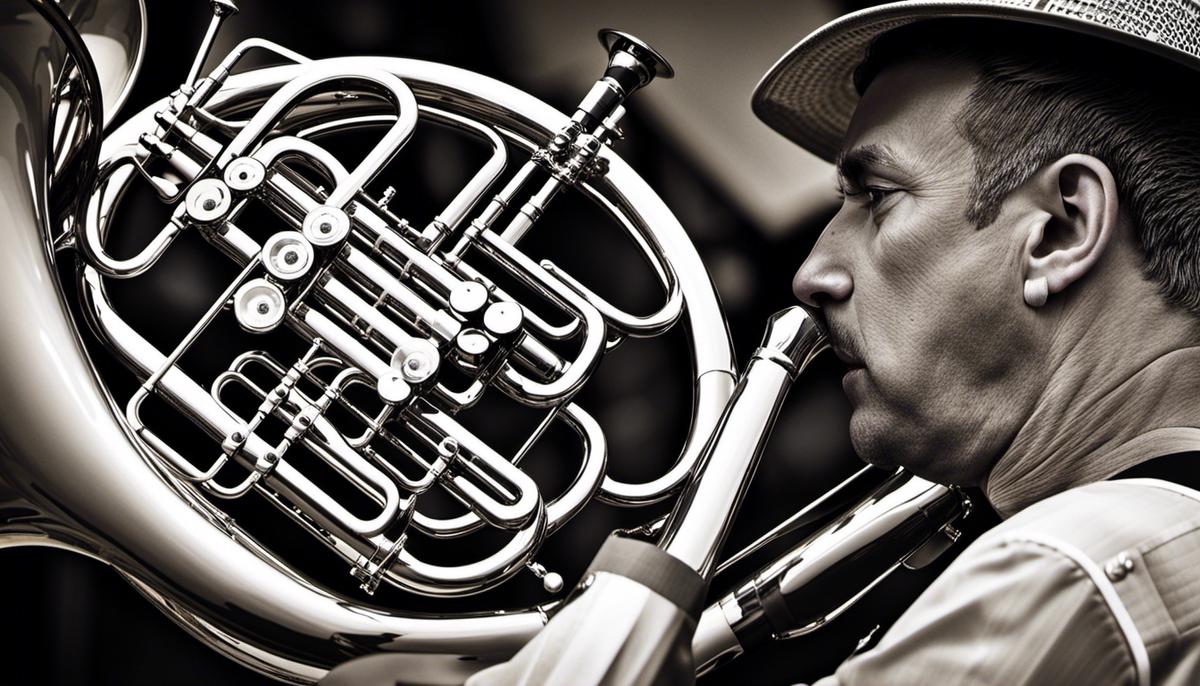
Musical Roles and Genres
Role of the French Horn in Orchestras, Bands, and Solo Settings
In the realm of orchestral and band music, the French horn cannot be ignored. Its prominence in symphony orchestras, concert bands, brass bands, and wind ensembles is notable. Its warm and resounding tone brings depth and richness to the ensemble’s harmonious sound. The French horn doesn’t just stick to harmonies; it also plays a key role in creating melodies, more so in symphonic and operatic compositions.
Typically, an orchestra comprises four French horn players, each assigned a unique and specific role. The first and third players are usually tasked with high notes, while the second and fourth deal with the lower notes. This structure adds texture and maintains balance in the ensemble’s sound.
In wind and brass bands, the French horn plays multiple roles owing to its ability to span a wide range of notes. It either enhances the main melody or provides rhythmic accompaniment. It frequently takes the lead in playing the primary or secondary melodies.
The French horn doesn’t only shine in groups; it is equally remarkable as a solo instrument. Numerous classical composers have created horn concertos that highlight its flexibility in terms of melody and texture. This instrument has found its way into various genres—jazz, pop, rock—you name it.
English Horn in Orchestras, Bands, and Solo Performances
The English horn, also known as the cor anglais, holds a unique position in the orchestra. It is mainly used in the orchestra and chamber music groups. Unlike the French horn, it belongs to the woodwind family and is most recognized for its distinctive melancholic and expressive sound.
In an orchestra, the English horn generally plays the alto voice, contributing to the darker tone color of the ensemble. It often performs solos in orchestral literature, sometimes for entire movements. Key composers like Beethoven, Mahler, and Dvořák have written significant parts for the English horn in their symphonies.
While not as commonly used in band music, some wind ensembles do include English horn parts, and it features in some chamber music arrangements for smaller ensembles. The English horn is also featured as a solo instrument in concerti and sonatas and can be heard in a number of film scores, where its plaintive sound is often used to convey sorrow or nostalgia.
Exploring Musical Genres with the French and English Horn
The French and English horn each bring their distinctive sounds to a plethora of musical genres, most notably classical orchestra and band music, which covers symphonic compositions, concertos, chamber pieces, and opera.
The French horn, in particular, has secured a presence in multiple genres including jazz, pop, rock, and a wealth of film scores. It isn’t uncommon for large jazz groups to weave in a section for the French horn, and film score composers frequently harness its substantial range and tonal fluidity to generate atmospheric soundscapes.
Conversely, the English horn, defined by its unmistakable sound, is primarily used in classical contexts. Particularly in pieces that call for a somber or emotionally-charged sound, such as certain orchestral and operatic compositions. However, there’s an increasing trend among modern composers exploring its potential within other contemporary genres such as film music, minimalist compositions, and the occasional jazz piece.
Overall, both the French and English horn play crucial roles within numerous musical settings. While the French horn maintains a slight edge in terms of versatility owing to its wider range and tonal flexibility, both instruments remain critical components of orchestras worldwide, each bringing its distinctive flavor to the ensemble’s overall sound.
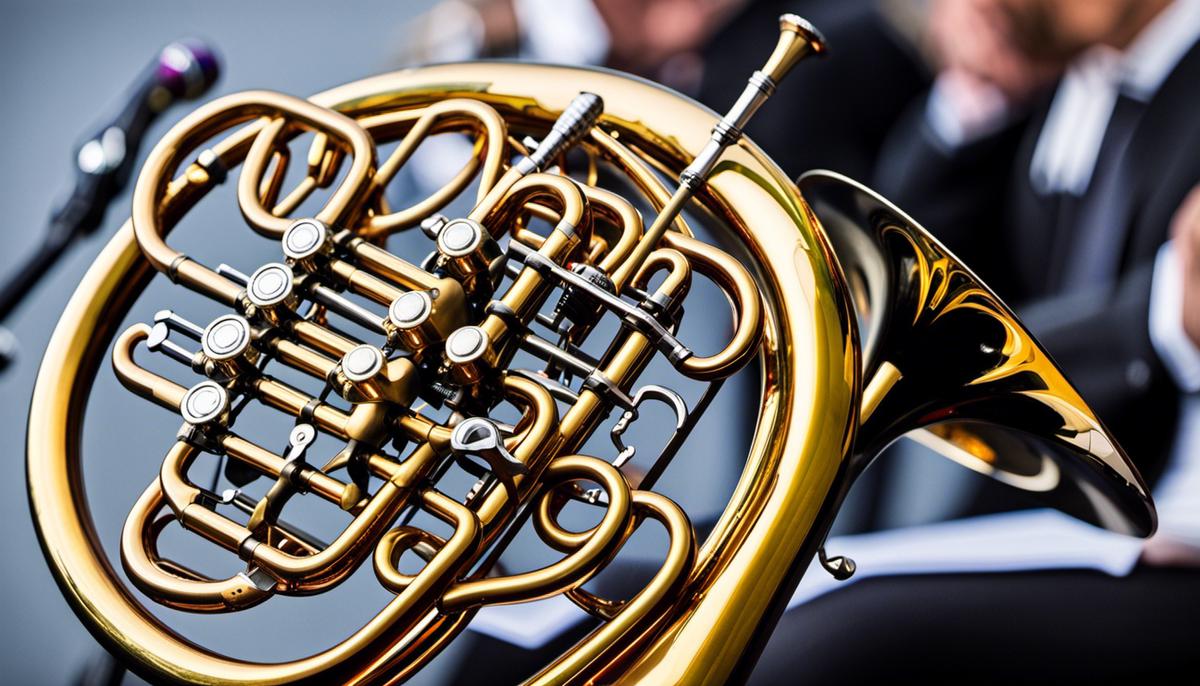
Distinguishing Between English Horn vs French Horn Sounds and Tones
The French Horn: A Blend of Mellow Complexity and Rich Resonance
Despite being named the French horn, this instrument hails from Germany and is recognized for its mellow complexity, offering a robust and resonant sound that’s strikingly different from its English counterpart. The brass tones of the French horn are not only capable of rising above an entire orchestra with its sharp high notes but can also produce the softest and most intimate sounds, striking a delicate and flexible balance. It boasts a wide pitch range covering the bass to the treble clef, often delivering what is best described as a “warm” or “rounded” sound, rich with velvety texture.
The timbre of the French horn is often likened to the human voice, due to its remarkable ability to shift tones, mimic the emotive quality of singing, and deliver a vast overtone spectrum, the longest amongst brass instruments. This attribute, although making it a challenging instrument to master, contributes to its signature warm tone that sets it apart.
English Horn: A Rarity with a Somber Tone
The English horn, curiously neither English nor a horn but a type of oboe, is known for its darker and more melancholic sound. This double-reed woodwind instrument has a unique pear-shaped bell contributing to its distinctive tone, which is fuller and deeper than the standard oboe. The English horn’s timbre possesses an evocative quality that often seems to convey an undertone of sadness or longing, making it ideal for renderings of melancholic melodies and solos.
Unlike the French horn, which has a comprehensive range, the English horn’s pitch range tends to stay within the alto and tenor register, thereby limiting its versatility in pitch but enriching its depth in tonality. It has a unique nasal quality which, though not as dynamic as the French horn in terms of varying tones, possesses a piercing timbre capable of cutting through the texture of an orchestra.
Choosing Between English Horn vs French Horn
Both the French horn and English horn offer unique tones and could effectively complement various musical arrangements. The French horn, with its wide range and capability to mimic the versatility of the human voice, could be the instrument of choice for arrangements where a wide variety of tones and pitch are required, from the beautifully soft and mellow to the strikingly loud and complex. Equally, its ability to blend with other instruments makes it a staple in most wind ensembles and symphony orchestras.
On the other hand, the English horn, with its somber, longing tone and depth in mid-range tonality, brings emotional depth to music. Its unique sound would be ideal for pieces that require complex emotional expression, such as those with sad or romantic themes. Its distinctive tone makes it a wonderful solo instrument and its piercing timbre helps it stand out in ensemble settings.
Whilst both these horns offer distinct features and tones, the choice between the French horn and the English horn would ultimately be influenced by what specific role it will play in a score and by the individual’s affinity to the sound that they prefer.

Conclusion
Discovering the intricacies of the English Horn vs French Horn therein lies an invitation to appreciate the artistry and craftsmanship that have evolved over centuries. This comprehensive comparison of these two majestic horns is as much a journey into history and culture as it is an exploration of music and sound.
Each instrument, with its unique genesis, design, and sound capabilities, offers musicians varying scopes for expression, enriched by the particular roles they play within different musical genres. Gracefully oscillating between the French and English Horn, this immersive exploration allows one to appreciate not just the musical versatility they bring, but their standing as cultural artifacts that reflect the evolution of artistic expression over time.
Additional Reading
Take some time to check out our other articles:
- Popular Music Industry Careers
- 10 Popular Music Jobs
- 7 Essential Music Production Tools Under $100
- AI In Music Production
Breve Music Studios publishes music to Spotify, YouTube Music, Amazon Music and more. Follow our pages on Facebook, Instagram, Twitter, TikTok, and YouTube.
Listen to our ensembles: Breve Orchestra, Breve Music Ensemble, Breve Low Brass Ensemble, Breve Woodwind Ensemble, and Jermaine Harris on Spotify.

